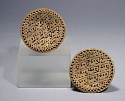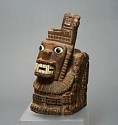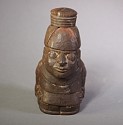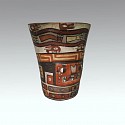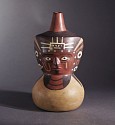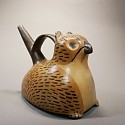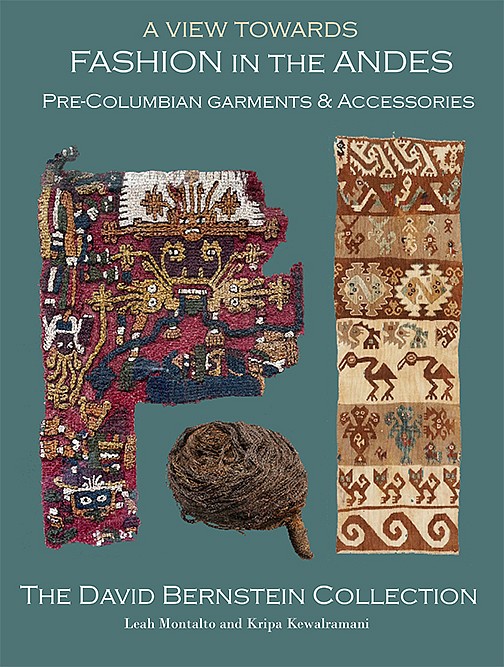
Peru, A View Towards Fashion in the Andes: Pre-Columbian Garments & Accessories
$49.95
David Bernstein Fine Art is proud to announce our newest publication, A View Towards Fashion in the Andes: Ancient Pre-Columbian Garments and Accessories. The book features Andean tapestries, tunics, and accessories, such as hats and headgear, sashes, and bags. Andean textiles are among the finest and most technologically advanced known in antiquity. The intricate patterns and designs woven into these textiles at first appear decorative to the untrained eye. But they often hold significant meaning, representing the cosmologies and animist belief systems of the societies that created them. The textiles’ sophistication and harmonic design structure reveal civilizations that were highly advanced yet also in tune with nature and the cosmos. Textiles played a pivotal role in the daily lives of the ancient Andeans, who used them as attire for ritual ceremonies, indicators of rank and status, and as burial shrouds to facilitate the transition of the spirits of the deceased to the afterlife.
Textile arts and fashion influenced Andean life, giving rise to an extensive array of highly sophisticated weaving techniques as early as 1500 BC. The craftsmanship evident in Andean textiles is a testament to their advanced artistic skills. Techniques such as looping, netting, twining, and plain weaves were used. Through symbols and imagery, the ancient Andeans’ textiles conveyed stories of creation, deities, shamans, and zoomorphic human-animal hybrids. The process of weaving itself was seen as a spiritual practice, connecting the artisan with the divine. The Paracas culture is especially known for its beautiful, richly colored embroideries, complex weaving techniques, and elaborate imagery. Often used to wrap and adorn the deceased, these textiles are unlike those of any other culture. In the later Wari and Inca cultures, textiles were also used as gifts to establish diplomacy between neighboring villages as well as for different ethnic groups to identify one another.
This full color book features over 210 large color plates of individual Andean textiles, revealing a unique, in-depth look at the fashion of the ancient Andeans. These weavings have been carefully chosen by David Bernstein over the course of 40 years, beginning in the 1970s. Special attention was paid to unusual weaving techniques, and many of the textiles were professionally conserved and mounted. The book is available as a downloadable PDF, or in print upon request.
Click here to download the order form to purchase a full-color hard copy of Fashion in the Andes.

Peru, 3 Pairs of Early Chancay Fertility Figures
These are rare and unusual Chancay figurines with painted surfaces in brick, beige and brown umber. The strong brown umber painted lines suggest an early Chancay phase with Wari influence. The figurines are wearing costumes that suggest important status, particularly the male figures, which each have a crown. The women wear braided hairstyles. The genitalia are exposed in enhanced proportions, likely part of a fertility symbolism related to agricultural production.
Period: Peru, Chancay,/Huari Central Coast, circa AD 900-1100
Media: Ceramic
Dimensions: Height Males c.10" Height of Females c.9"
Price Upon Request
M9014Hb




Peru, Central Coast Peruvian Wood Ear Spools
Probably late Huari or early Chancay, these light balsa wood ear spool carved in three sections, depicting a face, body and back. The design is cut out, with four rows of birds in profile – generally typical of Chancay or Chimu art. No glue or tree resin was used to keep the three sections together, rather they are carved perfectly to have a precise fit. Ear spools were used in the ancient Andes to display status and rank. Ex. Daniel Rifkin, acquired in New York prior to 1980.
Period: Peru, Wari, Central Coast, c. AD 650 - 1100
Media: Wood
Dimensions: Diameter: 3" x Depth: 4 1/2"
Price Upon Request
M4011













Peru, Early Nazca/Late Wari Tie- Dye Patchwork Rectangular Bag
This tie dye rectangular bag with discontinuous interlocking patchwork was probably used for carrying feathers. The bag was made from surplus squares left over from a larger mantle, utilizing the scaffold technique. Collected by Gunnolf Bjorkman who worked in Lima in the 1960's and settled in Buenos Aires.
Period: Peru, Nasca, South Coast, c. AD 300 - 700
Media: Textile
Dimensions: Length: 26" x Width: 4 1/2 in.
$7,250
91265





Peru, Huarmay Tapestry Border to a Poncho with Three Warriors
This classic Huarmay style tapestry is crafted in the classic Huarmay colors of ivory, blue, and red with black outlines. Each warrior wears different colors, and each holds a tumi in his left hand and wears an elaborate headdress with two long, forward-tilting plumes. Separating the warriors are blocks of ivory with three abstract birds on a diagonal. Along the bottom edge is a repeating classic step volute line in blue with a white outline. The Huarmay culture thrived during the Late Moche Period on the most Southern of the fourteen Moche valleys, and were influenced by the Wari. Mounted, in a Plexiglas box. Minor losses to the ivory central panel. Formerly in a New York private collection prior to 1979.
Period: Peru, Huarmay, Central Coast, c. AD 650 - 800
Media: Textile
Dimensions: Width: 48" x Height: 6 1/2"
$8,500
n9040
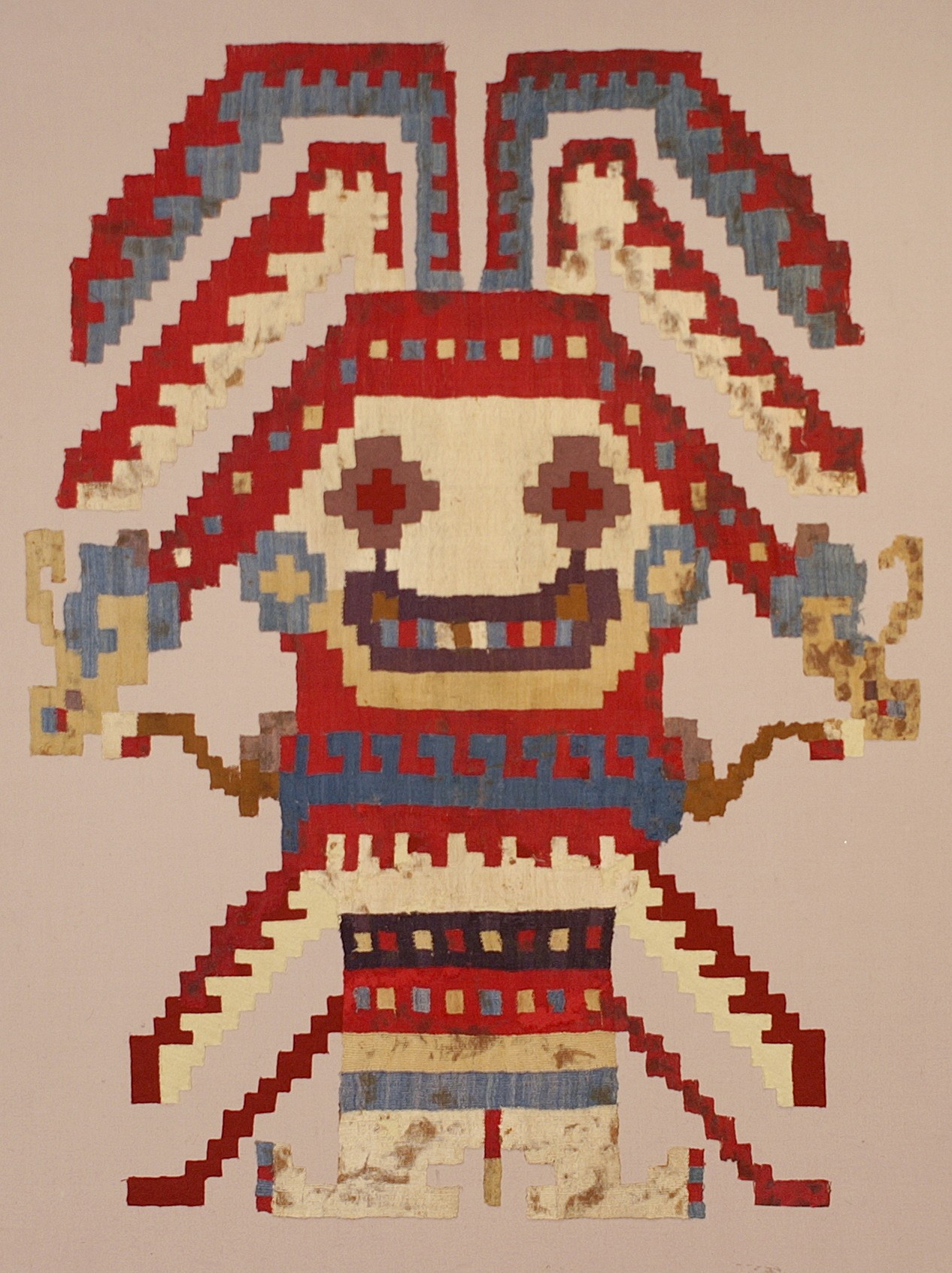



Peru, Huarmey Tapestry deity with rayed headdress
This is a very large single figure for any Peruvian weaving, and it was originally attached to a mantle of sheer cotton. The figure wears a headdress, ear spools, necklace, and tunic with a serpent belt in the red, blue and ivory colors typical of Huarmey textiles. The Huarmey Valley is the most southern in the Moche area and had, therefore, a lot of Wari influence in its art. This figure is stylistically more Wari than Moche in its abstract appearance.
Period: Peru, Moche, Huarmey Valley, circa AD700-900
Media: Textile
Dimensions: Length 32" x Width 24"
Price Upon Request
92305




Peru, Large fragment to a Wari tunic in Unusual Colors with Abstract Monkey Faces
The fragment consists of two large sections that join, making it almost 60 inches in length. The design is of opposing monkeys in profile. Both profile monkey faces also combine to create a third, larger monkey face in two colors. The monkey’s tail turns into a step fret motif, typical of Wari tunics. The thread count is high, at around 120 per inch. The warps are of cotton and the wefts are of fine alpaca. Cotton warps suggests that the tunic was woven on the coast.
Period: Peru, Wari, South Coast, c. AD 600 - 900
Media: Textile
Dimensions: Overall length is 60" x Width of 20"
Section A Length: 30" x Width: 20"
Section B Length: 30" x Width: 20'
$6,950
n7018
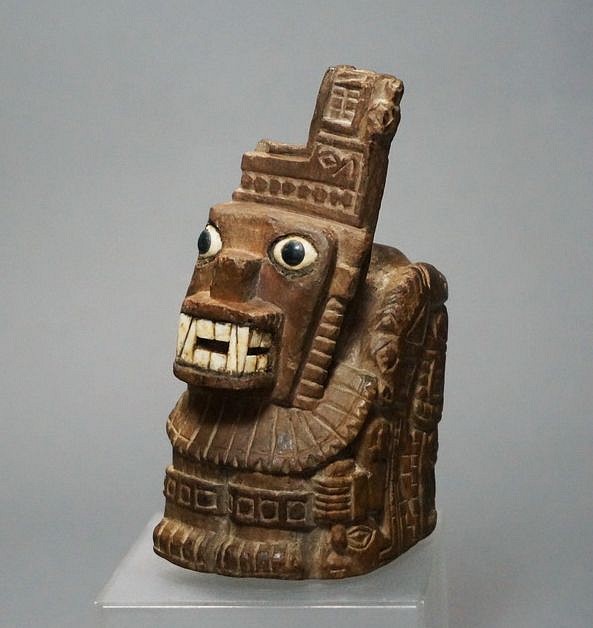




Peru, Large Wari Carved Wood Lime Container Representing a Decapitator
This large wood lime container is carved in the form of a classic Wari decapitator holding a trophy head in his right hand. These containers were used to store lime, which assists the body in metabolizing cocaine alkaloids from ground coca leaves. The opposite side would have had him holding a tumi knife. The decapitator is wearing an elaborate costume with a puma mask and a tapestried tunic with feline profile faces. Below the mask is an elaborate pectoral of trapezoidal plaques. One half of the container is missing, and the inside reveals a storage chamber. The puma is elaborately decorated with classic Tiahuanaco motifs from the Gateway of the Sun. Evidence of inlays in the eye sockets exist. The container portrays a major sculpture in wood for this period. Another lime container in the National Museum of Copenhagen of the same height, 5.75" is illustrated in "Art of Empire, Museum of Primitive Art" - fig. 80.m. There is a chapter in the Peruvian publication Los Dios del Antiguo Peru - Dioses De Pachacamac El Idolo Y el Templo, pages 159-175, which discusses a carved wood idol on a staff. This staff in the book has many elements that are similar to this lime container, specifically the arched serpent and profile face.
Period: Peru, Huari South Highlands/Coast, circa 650-900A.D.
Media: Wood
Dimensions: Height: 4 1/2"
$8,000
97158
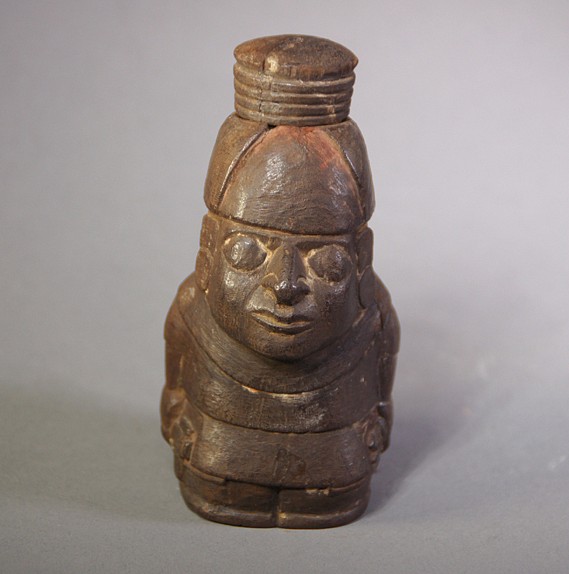




Peru, Large Wari wooden lime container in the form of a seated man
This large Wari wooden lime container is in the form of a kneeling figure carrying an axe in one hand and a group of darts in the other. He wears a circular hat which is also the lid of the container and a pair of earspools.
Period: Peru, Wari South Coast, circa AD650-900
Media: Wood
Dimensions: Height 4 3/4 in.
Price Upon Request
93123
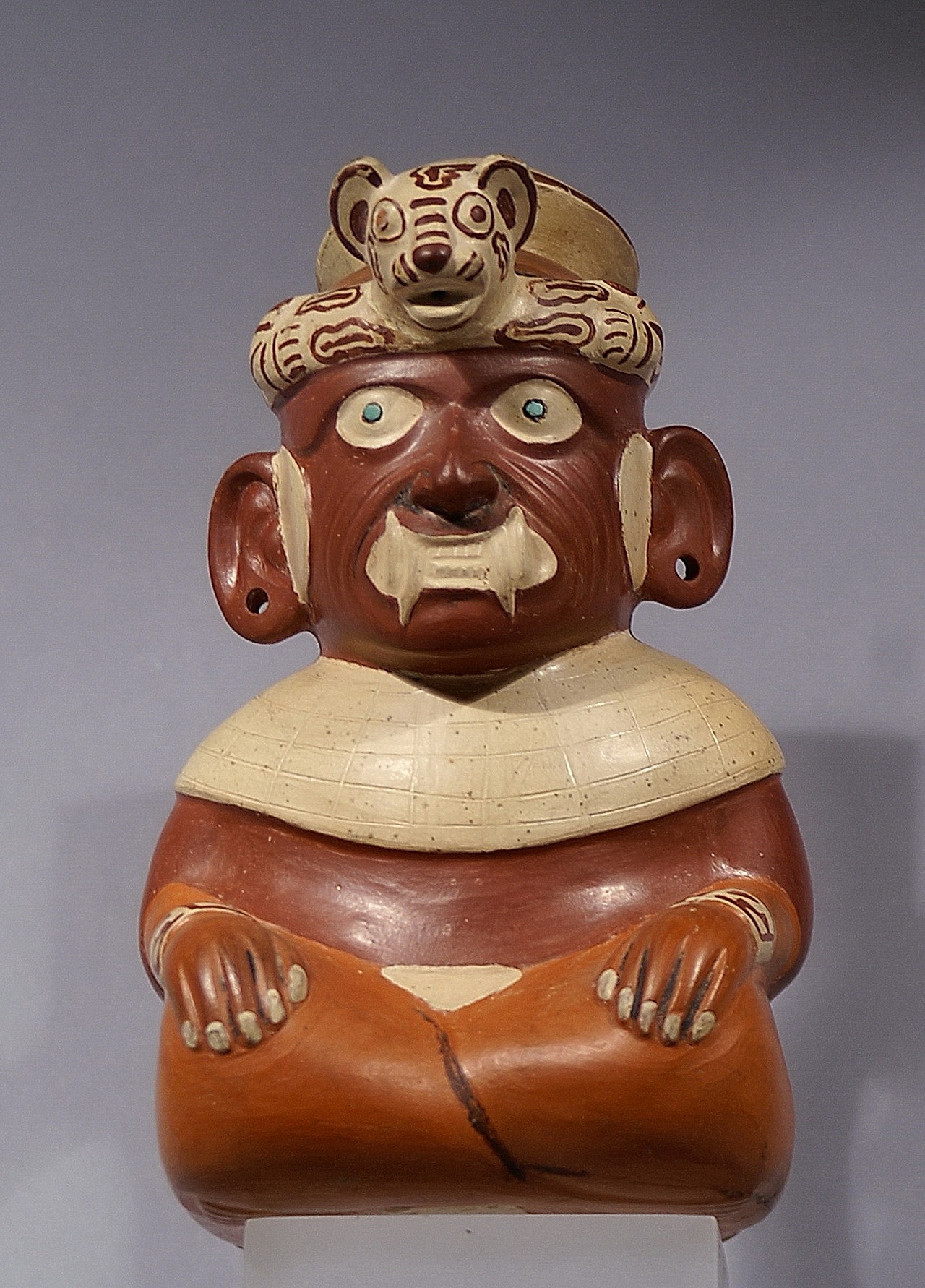






Peru, Moche I - II Effigy Vessel of the Decapitator Ai Apaec
This is an early version of the Decapitator deity known as Ai Apaec. The deity always wears a feline headdress, but early versions also show him with a turban. This headdress not only has a puma skin but also a Plume of feathers represented by the conical form ontop of his head. He also wears a lovely Pectoral with individual plaques sewn onto a leather backing. The Decapitator is one of the earliest supernaturals in the Moche ceramic sequence, and he frequently carries a tumi knife and a decapitated head. The Decapitator continued into later cultures, notably the Wari and the Chimu. Formerly in a European collection since the 1970s.
Period: Peru, Moche I, North Coast, circa AD100-300
Media: Ceramic
Dimensions: Height: 7 1/2"
$29,000
M7073
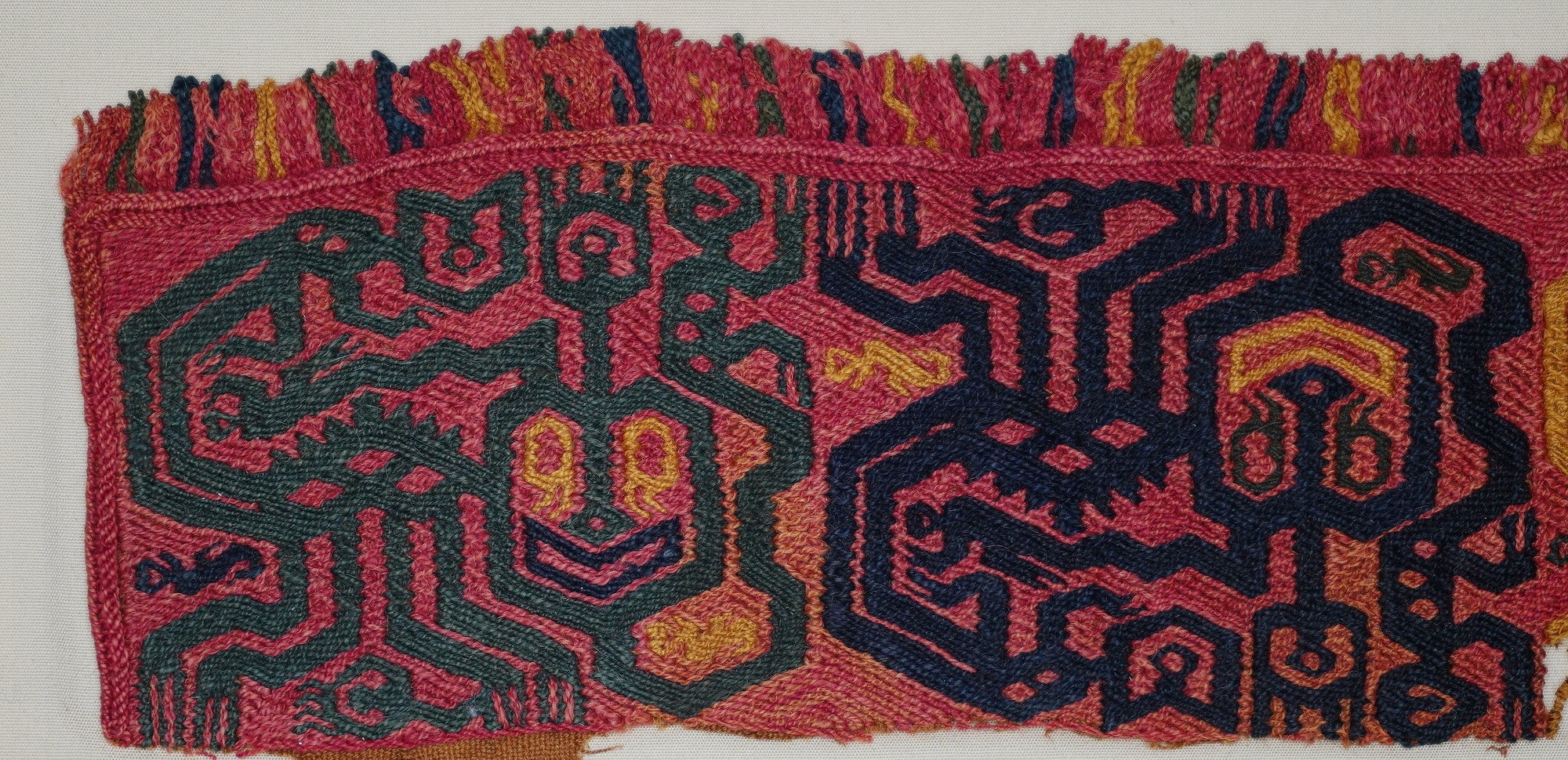
Peru, Paracas Border Section with Three Colorful Felines on Red Gound
Paracas textiles served as a medium of communication between the realms of the living and the dead. This Linear style border section features three embroidered feline figures in alternating colors and positions. One edge has its original fringe intact. The feline figures represent the "Oculate Being," a prevalent theme occurring throughout the Paracas period. Here the feline motif is presented with an oversized, characteristically heart-shaped head with a wide smiling mouth and hexagonal eyes. Another geometricized form springs from the center of each of the feline heads. Long slender appendages forming the legs of the creatures end in forked claws or transform into smaller feline creatures. The plain weave red background and embroidered Oculate Being motifs are woven in green, blue, and yellow, creating a beautifully vivid contrast. This style is characteristic of the textiles that were found at the Necropolis at Wari Kayan. This textile is from the Early Horizon, Epoch 10. It is also illustrated in ANCIENT PERUVIAN TEXTILES by Ferdinand Anton, London, 1984, fig. 47. Ferdinand Anton collection prior to 1980. Good color and pressure mounted in a frame.
Period: Peru, Late Paracas, South Coast, c. 300 - 200 BC
Period: Peru, Late Paracas, South Coast, c. 300 - 200 BC
Media: Textile
Dimensions: Height: 3" x Length: 12"
Price Upon Request
92016
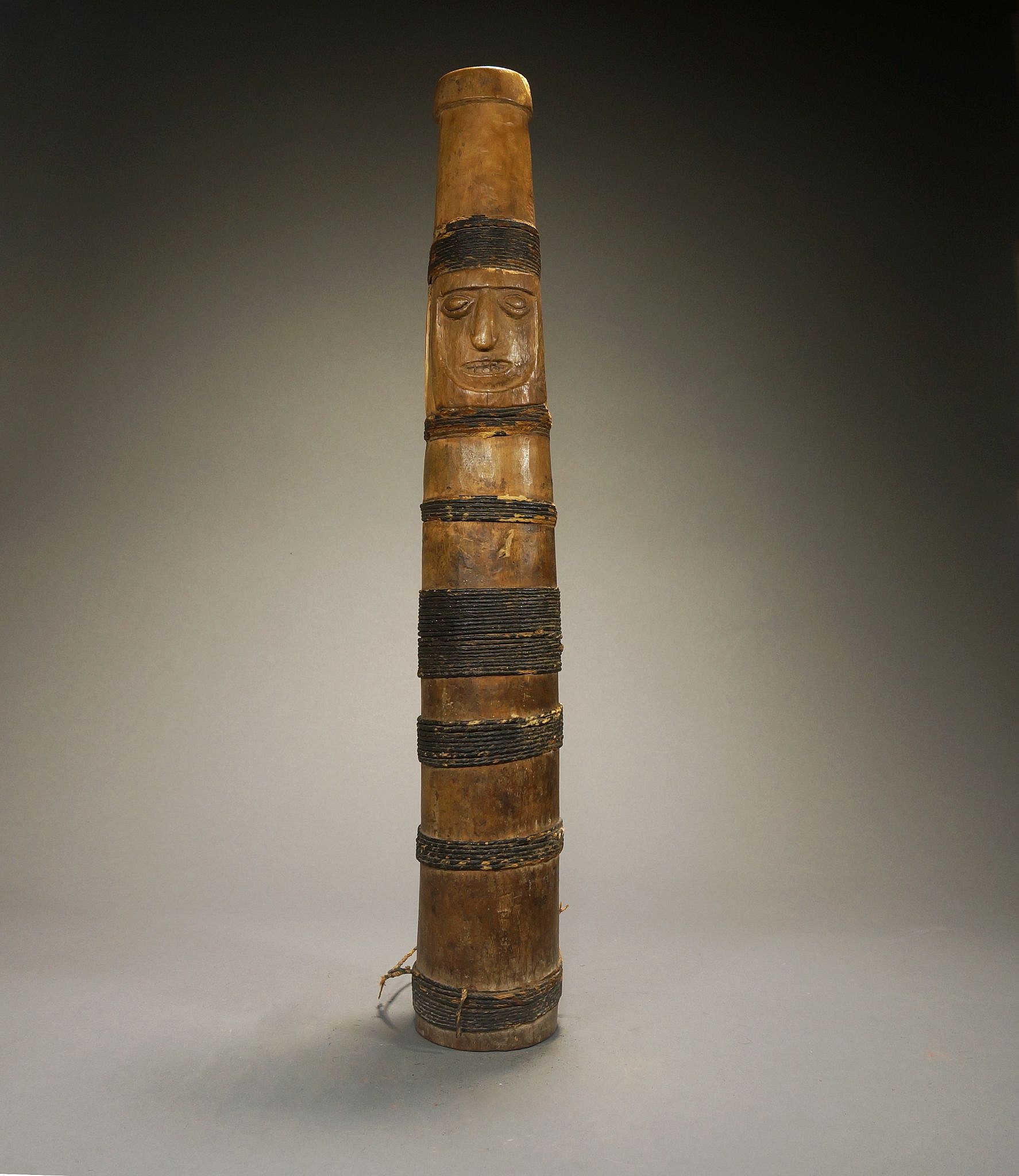



Peru, South Coast Wari Carved Wooden Trumpet with Face
This Wari trumpet has been wrapped in bands with a tar covered cotton rope. It has the typical trumpet pitch. This is a rare object to find so intact.
Period: Peru, Nazca, Late phase, South Coast, circa AD600-800
Media: Wood
Dimensions: Length: 16.5 Inches
$7,500
n3018

Peru, Three Wari Woven Tabs with Animal Heads
These woven tabs with stylized grinning toad faces were once part of a sash. The tabs are woven in orange, green, blue, white and black on a red ground. A similar set of tabs is illustrated in Animal Myth and Magic,by Vanessa Moraga, p. 110.
Period: Peru, Wari, South Coast, c. AD 600 - 900
Media: Textile
Price Upon Request
91095a


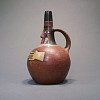

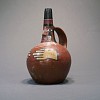

Peru, Two Wari Strap Handle Effigy Vessels with Faces on Spouts
Two lovely miniature single spout vessels depicting corn gods. Both are wearing 5 strand necklaces nicely tied at the back. These are stunning examples done in miniature with gestures of exaggerated hands holding the stomach as is after a feast. There is a group of Wari vessels which have necklaces and large hands, which could mean that they came from the same tomb. A similar example is illustrated in WARI LORDS OF THE ANCIENT ANDES. Pg 83. T-L tested in Berlin.
Period: Peru, Wari South Coast, circa AD650-900
Media: Ceramic
Dimensions: Height 6 3/4"
Price Upon Request
94120A
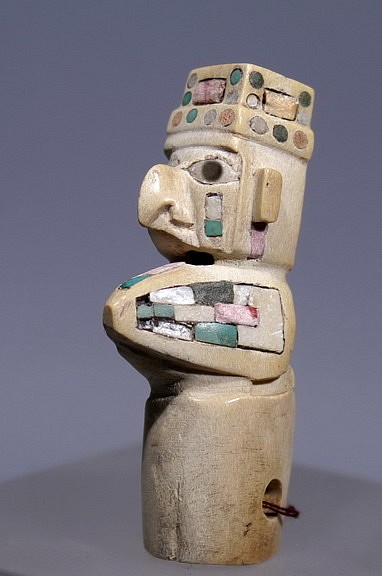




Peru, Wari Atl Atl Grip with Owl Deity With Head Turned Backward
This fancy carved bone grip has a "Sphinx like" appearance, with the torso and face of an owl, but its head is turned backwards. The inlays are original and made of shell, turqkuoise and snail shell. The hat is a classic Wari four-cornered hat, only worn only by the Wari culture.
Period: Peru, Wari, Central Coast, circa AD650-1100
Media: Shell
Dimensions: Height: 2 3/4" inches
Price Upon Request
M7153
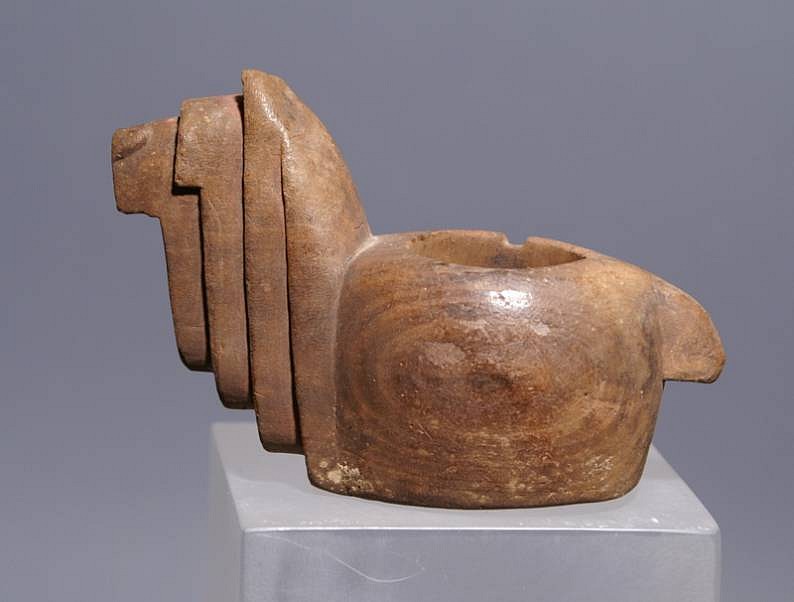





Peru, Wari Carved Wood Konopa in the form of an alpaca
Konopas were sacred offering containers carved in the shapes of llamas and alpacas. This example is carved from balsa wood in the unmistakable form of an alpaca, distinguished by its long hair, especially flopping over the eyes. A round cavity was carved into the animal's back for the purpose of holding an offering. Once filled, probably with a mixture of llama or alpaca fat and blood, the carving was subsequently placed in pastures to secure the fertility of herds and the land, both so essential to the ancient Peruvians. Most known extant konopas are from the later Inca period and were generally carved from stone. A wide variety of Inca stone examples are illustrated in "Gold of the Andes: The Llamas, Alpacas, Vicunas and Guanacos of South America," 2 vols. (Barcelona, 1994, Vol. I: 20 and 21). The stone Inca examples of alpaca konopas are from Helmut Schindler "The Norbert Mayrock Art Collection from Ancient Peru" (2000: 320).
Period: Peru, Wari, South Highlands, circa AD650-1100
Media: Wood
Dimensions: Height 2 1/2"
Price Upon Request
94016




Peru, Wari Carved Wooden Dog with Bowl in Mouth
The dog has a fluffy tail and is holding a bowl in its mouth, asking for food.
Period: Peru, Wari South Coast, circa AD650-900
Media: Wood
Dimensions: Length: 7"
Price Upon Request
N3033



Peru, Wari Carved Wooden Oppossum with Leg Missing
This opossuml has large feet, a long tail and a long snout. He has ears which are are extremely short. His back feet have prehensile thumbs.
Period: Peru, Wari South Coast, circa AD650-900
Media: Wood
Dimensions: Length: 9 1/4"
Price Upon Request
n3032
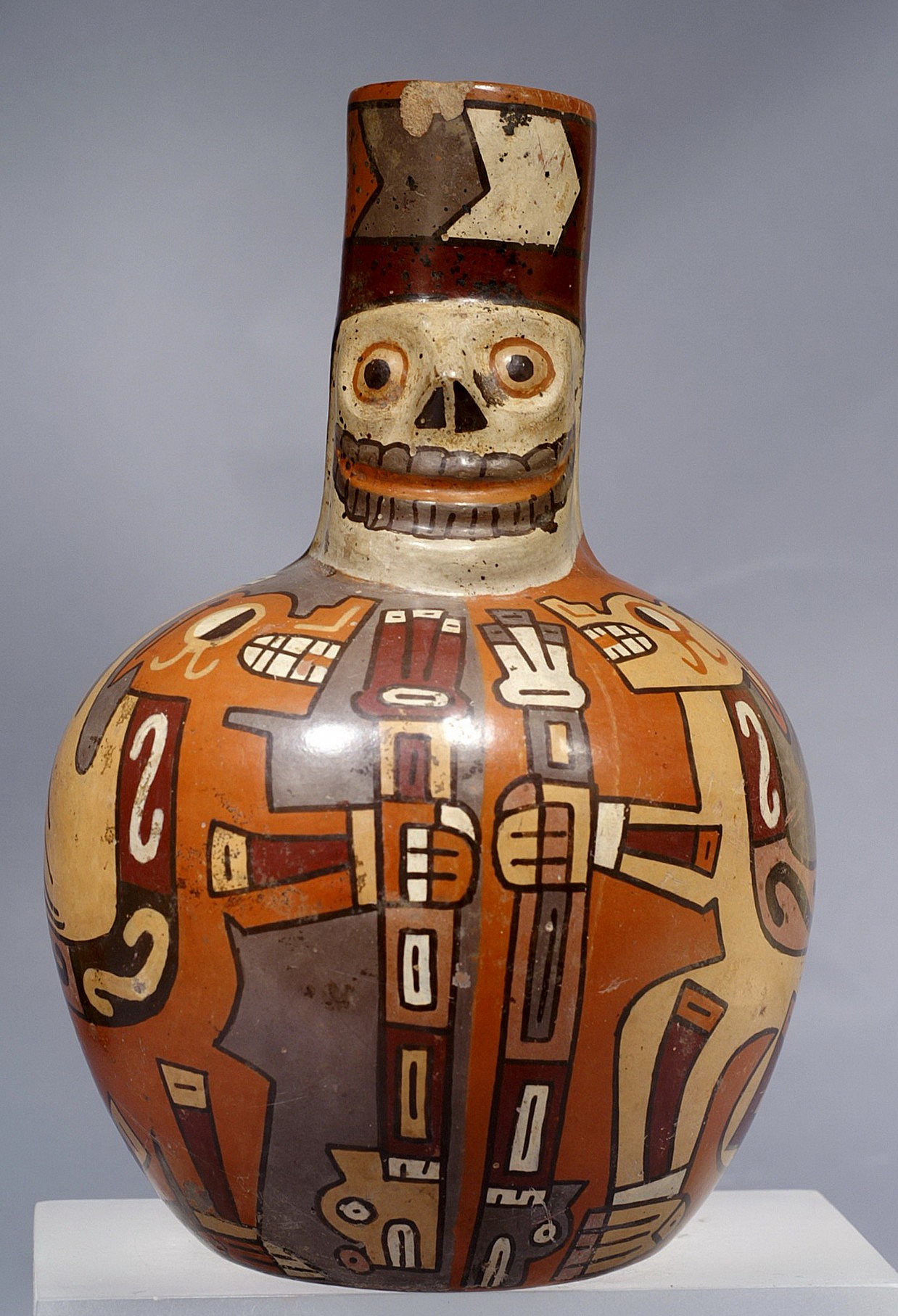




Peru, Wari Death-head Vessel with winged felines
This beaker with skeletal head in relief was painted with winged felines holding staffs. Both the skeletal relief and the mythical felines are characteristic of Wari pottery. A smaller similar vessel in the American Museum of Natural History in New York is published in Alan Lapiner, "Pre-Columbian Art from South America (1976: #542) and Margaret Young-Sanchez, "Tiwanaku: Ancestors of the Inca" (2004: fig. 6.6) Height 6 3/4" compared to the above of 8". The skeletal deity wears a class Wari tapestry tunic and a lovely hair-do on his black. The crouching winged pumas holding staffs are classic features of Wari Art & Iconography. This vessel was formerly in a German collection collected prior to 1970.
Period: Peru, Wari, South Coast, circa AD900-1100
Media: Ceramic
Dimensions: Height: 8"
Price Upon Request
M7046
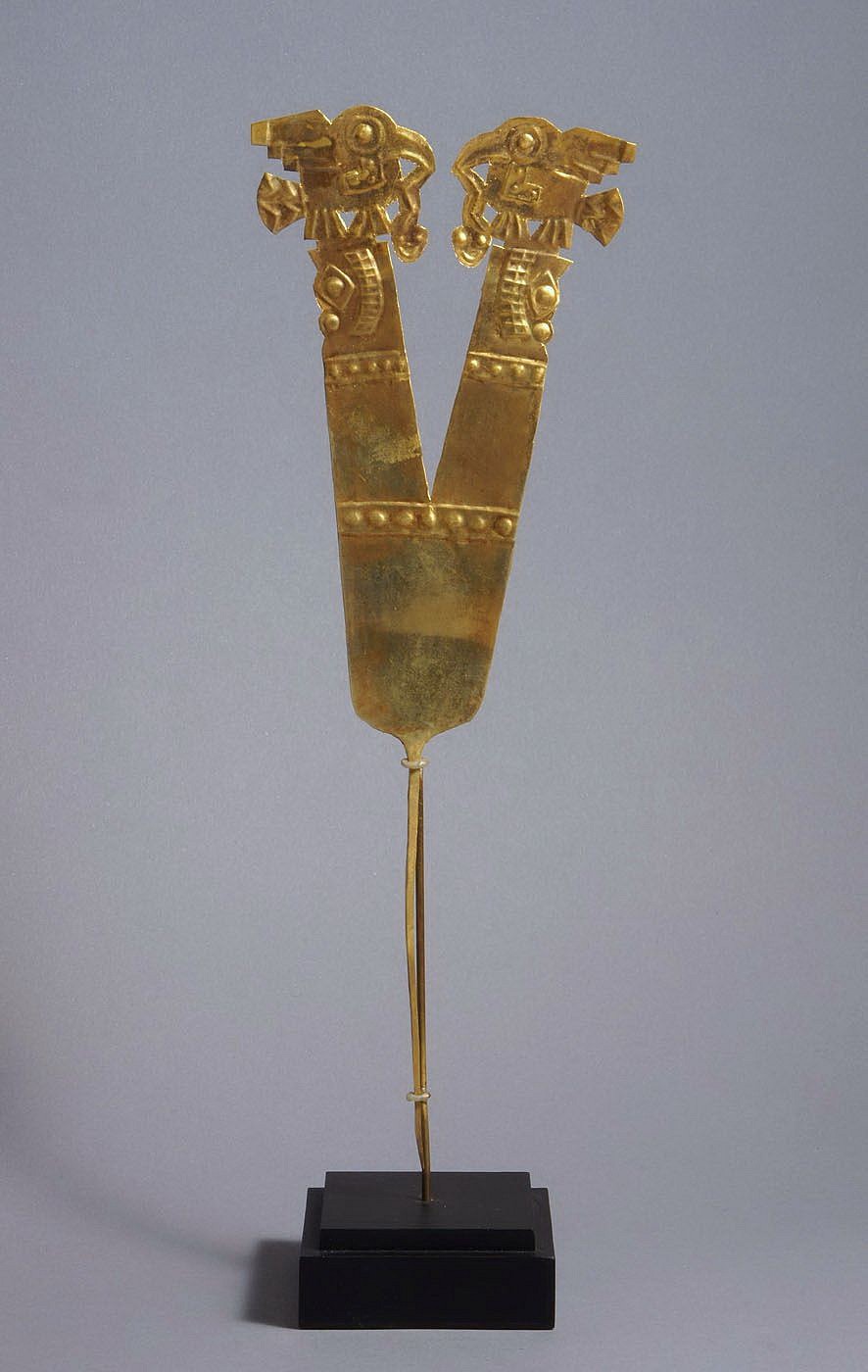


Peru, Wari Double-headed Gold Feather Plume with Embossed and Cutout Decoration
The feather plume is worked with embossed designs of two cutout birds standing on Puma heads and holding serpents in their beaks. The Puma Head can also be seen as a Condor head facing in the downward direction and seen in the classic Wari Tunics. The surfaces are beautifully burnished. A similar plume in the Berlin Museum measures 8 ¾†and is illustrated in WARI - Lords of the Andes, fig. 216. This plume is unusual in that it has two "branches" and is worked with both cutout and embossed designs while the others only have embossed work. Formerly in the collection of Robert Sonin.
Period: Peru, Wari, Central Coast, c. AD 650 - 1100
Media: Metal
Dimensions: Height 10 1/2"
$12,500
M7122b




Peru, Wari Effigy Vessel of a llama hoof
The llama hoof is decorated in three bands, the upper with two sets of sun/moon heads facing each other. The middle band has an undulating serpent and the lower band is a black on white llama skin decoration.
Period: Peru, Wari, South Highlands/Coast, circa AD650-900
Media: Ceramic
Dimensions: Height 5"
Price Upon Request
M3079




Peru, Wari Embossed Gold Feather Plume Decoration Depicting a Pair of Vultures
This double-headed design features two cutout birds of prey holding serpents in their beaks. This style of gold plume would have been attached to the headdress of a high-status individual, signifying strength and power. A less elaborate gold plum by the same artist is illustrated in WARI: Lords of the Ancient Andes, page 227. Acquired from a New York collector prior to 1990.
Period: Peru, Wari, Central Coast, c. AD 650 - 1100
Media: Metal
Dimensions: Height 11 1/4" Weight: 26 grams.
Price Upon Request
m7122






Peru, Wari Four-Corner Pile Hat Decorated in 3 Registers
The top register of this hat features 7 repeating panels in alternating colors, with background colors in red, green, and blue. The figure depicted in each panel is a totemic column consisting of (1) an abstract Rayed Deity’s face at bottom (2) a second deity face (in the middle) and (3) an elaborate headdress representing a bird with outstretched wings at the top. The faces and feather motif may derive from the Frontal Staff Deity, a major figure in Highland iconogpahy. The second register features an undulating band of white, red, blue, tan, and gold, on a dark brown ground. The lower register features a beautiful repeating band of geometric designs on a green ground, representing 8 repeating Reyed Deity faces. A four-cornered pile hat with similar elements is in the Metropolitan Museum of Art’s permanent collection. From the estate of Leslie Orgal, PhD - La Jolla, CA. prior to the 1980s.
Media: Textile
Dimensions: Height:. 4 1/2". x Length: 4" x Width:. 4"
$6,500
p4125

Peru, Wari Gold and Silver Bicephalous Arc (Serpent Deity) with Dangles
This ornament represents a plume of features, intended to be placed into a gold headband. When worn in ceremonies, the kinetic dangles would have moved and reflected a variety of colors of warm light, attracting the attention of onlookers.
Period: Peru, Wari South Coast, c. AD 650 - 1100
Media: Metal
Dimensions: Heigh: 8 1/2" x Width: 6" Weight:26 grams.
$7,800
p4162
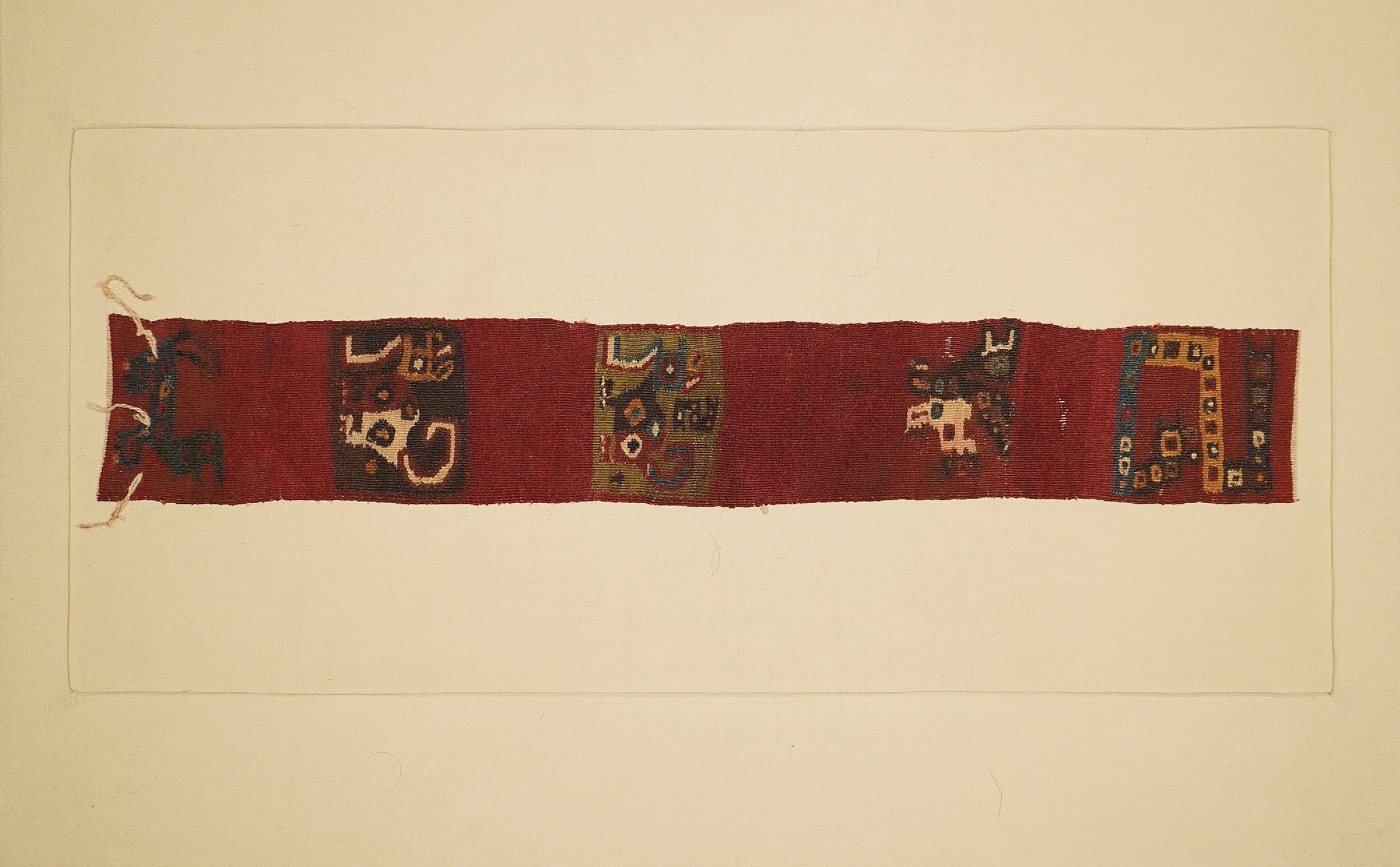




Peru, Wari Headband with 5 Animals Deities
This is a section of a headband with 5 different animal images, including a pair of intertwined serpents, a condor deity, and three chimeric feline deities. The animal deities are depicted with a variety of bright and neutral colors on a deep red ground, a classic Wari color arrangement. Excellent color. Ex. collection Ferdinand Anton, Germany, prior to 1980.
Period: Peru, Wari South Coast, c. AD 700 - 900
Media: Textile
Dimensions: Textile: W. 17" x W. 2 1/2"
Mat: W: 20" x H: 16"
$1,000
79045
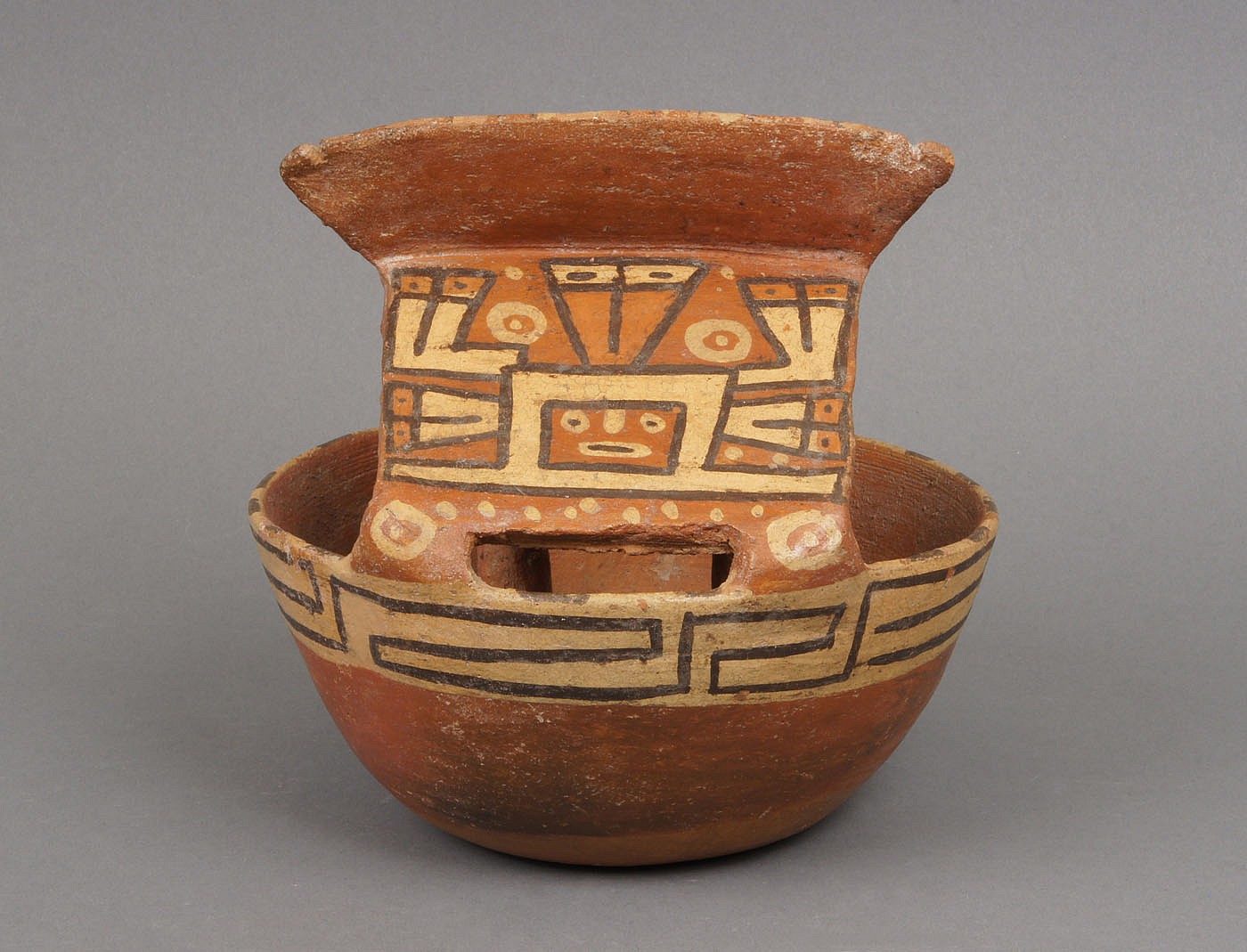





Peru, Wari House Vessel with Overhanging Roof on Two Pillars
An effigy bowl in the form of a temple with a decorated roof. The sloping roof supported by pillars was likely decorated with a fresco. There are some temples in Southern Peru which still have traces of fresco decoration dating from the early Wari period. The columns taper to the top and have a lentil support. Photographed by Justin Kerr for Alan Lapiner, New York, June 1968.
Period: South Coast Peru circa 700-950A.D.
Media: Ceramic
Dimensions: H. 7 in.
$5,400
91993
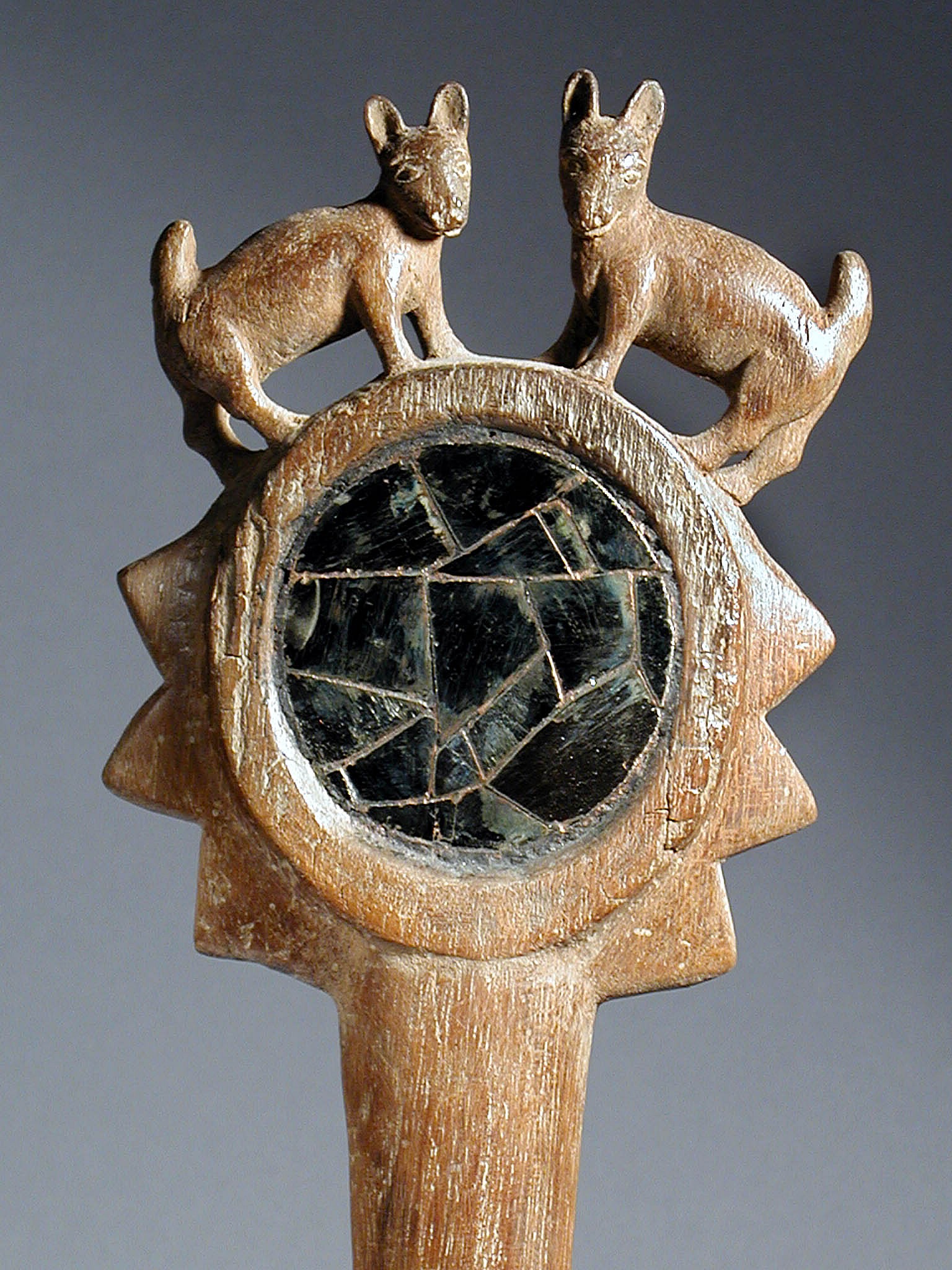


Peru, Wari Long Handle Wood Mirror Back with two deer carved on top
Elegantly carved wood handled mirror decorated with two felines perched on top facing outward. The mirror frame is carved with a mace-like knobs to give an overall impression of a scepter. The verso side is plain.
Period: Peru, Wari, Central Coast, circa AD650-1100
Media: Wood
Dimensions: Length 14 1/4"
Price Upon Request
94189






Peru, Wari Miniature Effigy of a Man with Large Hands
This is a common style of figurative vessel painted by the Wari and most likely represents a feasting man with a full belly. The Wari held large communal feasts where food was served along with chicha, corn beer, which was spiked with psychoactive plants such as Peruvian pepper – as found at Wari archaeological sites. This vessel is one of a set that was found at the same gravesite.
Period: Peru, Wari, South Coast, c. AD 650 - 900
Media: Ceramic
Dimensions: Height 4 3/4"
Price Upon Request
n3024





Peru, Wari Pair of Gold and Silver Ear Plugs
This pair of ear plugs has gilt gold fronts attached to silver plugs. The silver plugs were made using a wood matrix, which can be seen in a few exposed areas on the back. It is quite rare to see the wooden matrix intact underneath the gold as it usually disintegrates within a few hundred years. Similar ear spools are illustrated in PRE-COLOMBIAN ART OF SOUTH AMERICA by Alan Lapiner, plate 566.
Period: Peru, Wari, South Coast, c. AD 600 - 750
Media: Metal
Dimensions: Diameter: 2 5/8" x Depth: 3 1/8"
$7,500
n8032




Peru, Wari Polychrome Kero
This is a very colorful example of a classic Wari kero wtih the facial features in relief. There are three registers above the deity's face and one below. Ex-collection Hans Monheim (Achen, Germany).
Period: Peru, Wari, South Highlands, c. AD 650 - 1100
Media: Ceramic
Dimensions: Height 71/4"
Price Upon Request
M4087
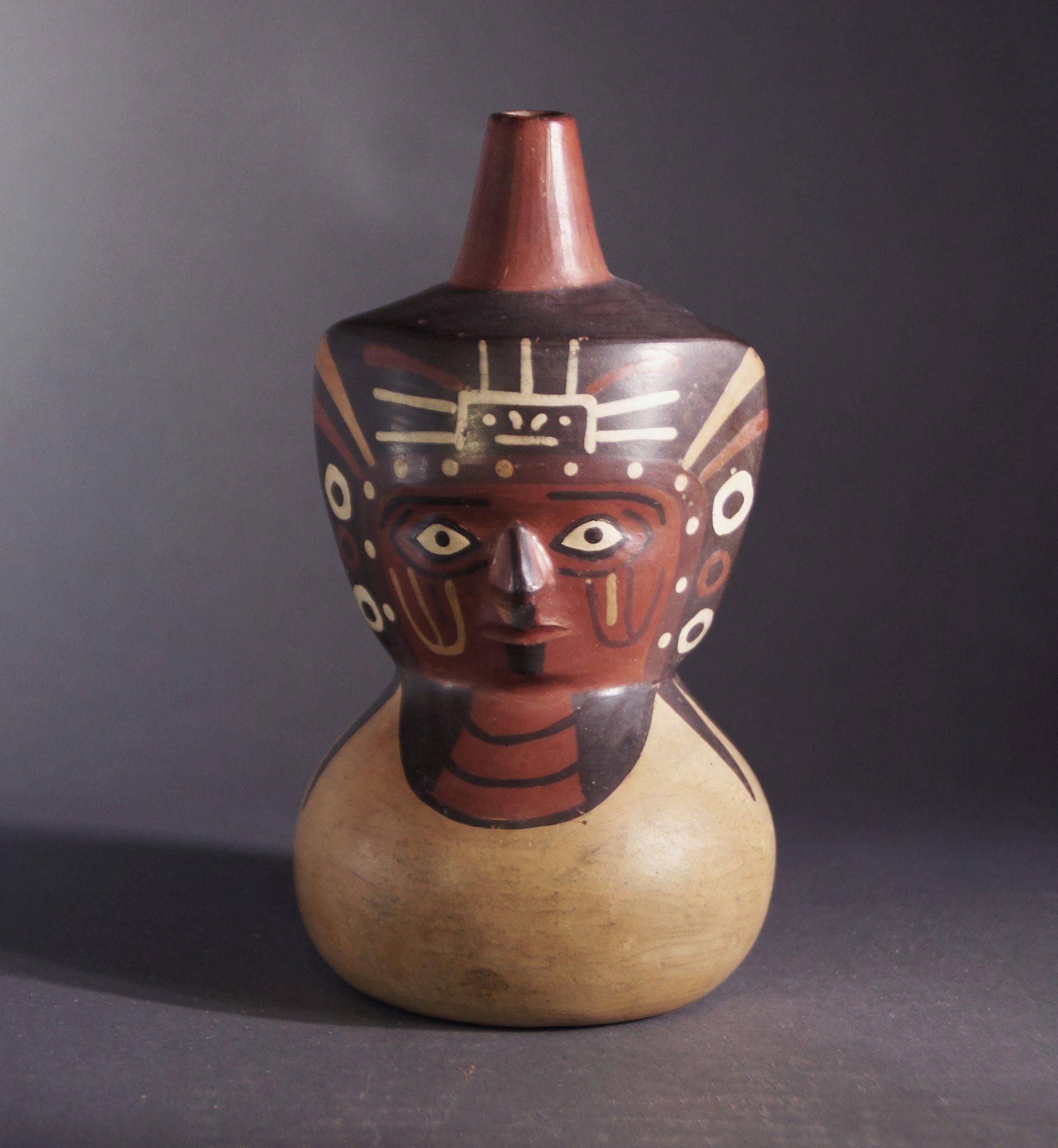


Peru, Wari Single Spout Figural Bottle with Elaborate Facial Decoration
This effigy vessel is painted with an individual wearing a diadem on his headdress and as well as a triple-strand necklace, indicating that he is a shaman or other important personage. He wears a black head covering, which is depicted draped around the shoulders. Ex. collection Anton Roeckl, Munich. T/L tested in Berlin.
Period: Peru, Wari, South Coast, c. AD 600 - 900
Media: Ceramic
Dimensions: 6 in.
Price Upon Request
94114A


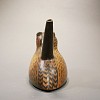


Peru, Wari Single Spout Owl Effigy Vessel in tan with black highlights
The effigy has black dashes representing feathers along its body. The chest of the owl is painted a lighter shade of tan with two feet protruding from the base. A very similar vessel is illustrated in José Antonio Lavalle "Nazca" (1986: 158). Ex-Collection Monheim (Achen, Germany).
Period: Peru, Wari, Coastal, circa AD650-1100
Media: Ceramic
Dimensions: Height 8" (20cm) x Length 8.5" (21.5cm)
Price Upon Request
M4093
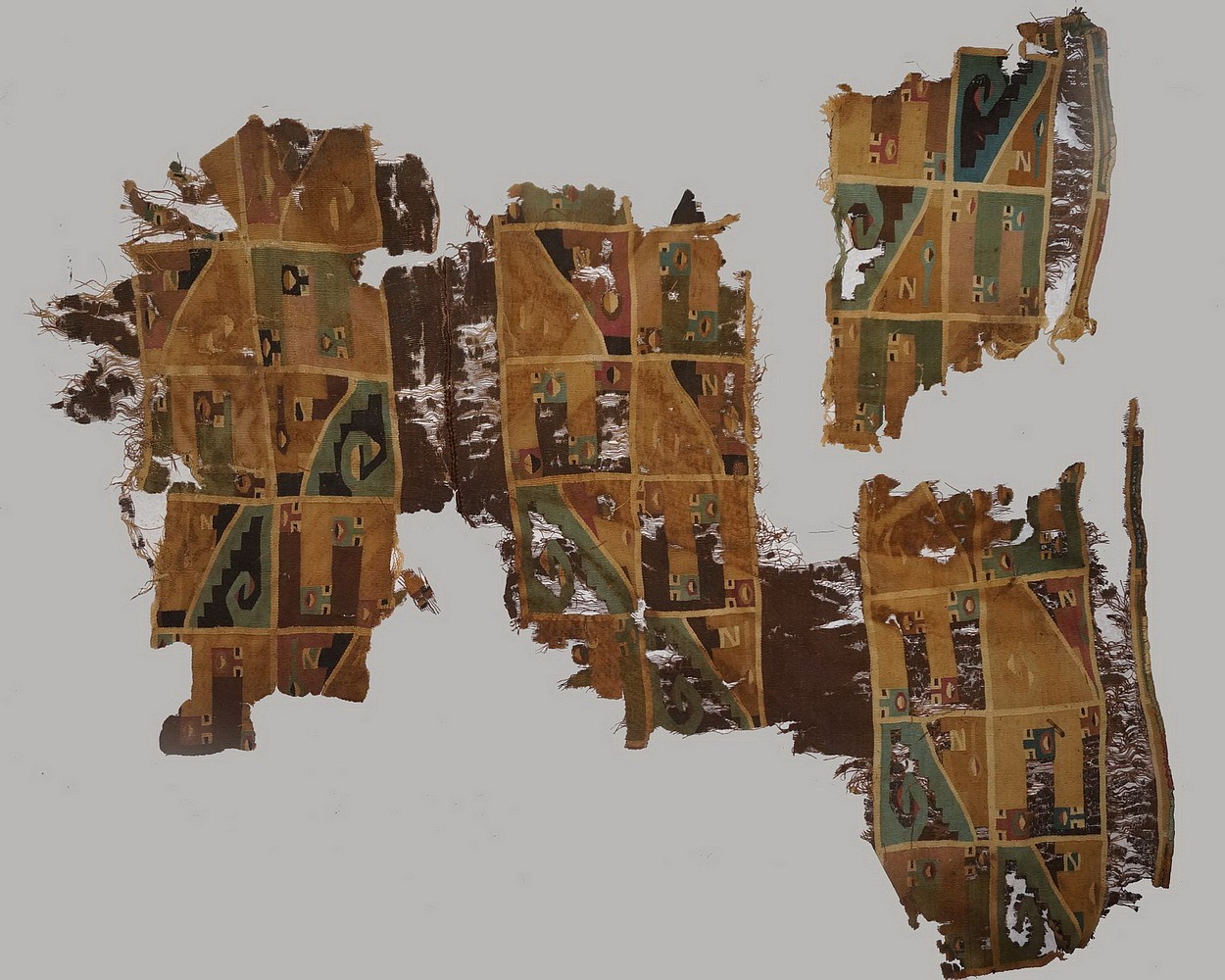



Peru, Wari Tapestry Sections to a Tunic from the Highlands
The tunic is a very finely woven section which depicts the classic step fret and puma motif. One large section includes the central seam with compressed design. Originally the tunic was woven with four bands of design separated by solid brown bands and the side seams had a compressed design. The warps are twisted with brown alpaca and white cotton indicating that the tunic was woven in the highlands. Included with the two main sections there are four additional sections that are incomplete.
Period: Peru, Wari, Highlands, c. AD 550 - 750
Media: Textile
Dimensions: Width: 30" X Height: 30"
Section: Width: 8" X Height 10"
4 extra sections measure from widths 5 1/2" to 8" and height from 5 1/2" to 12"
Price Upon Request
n7062
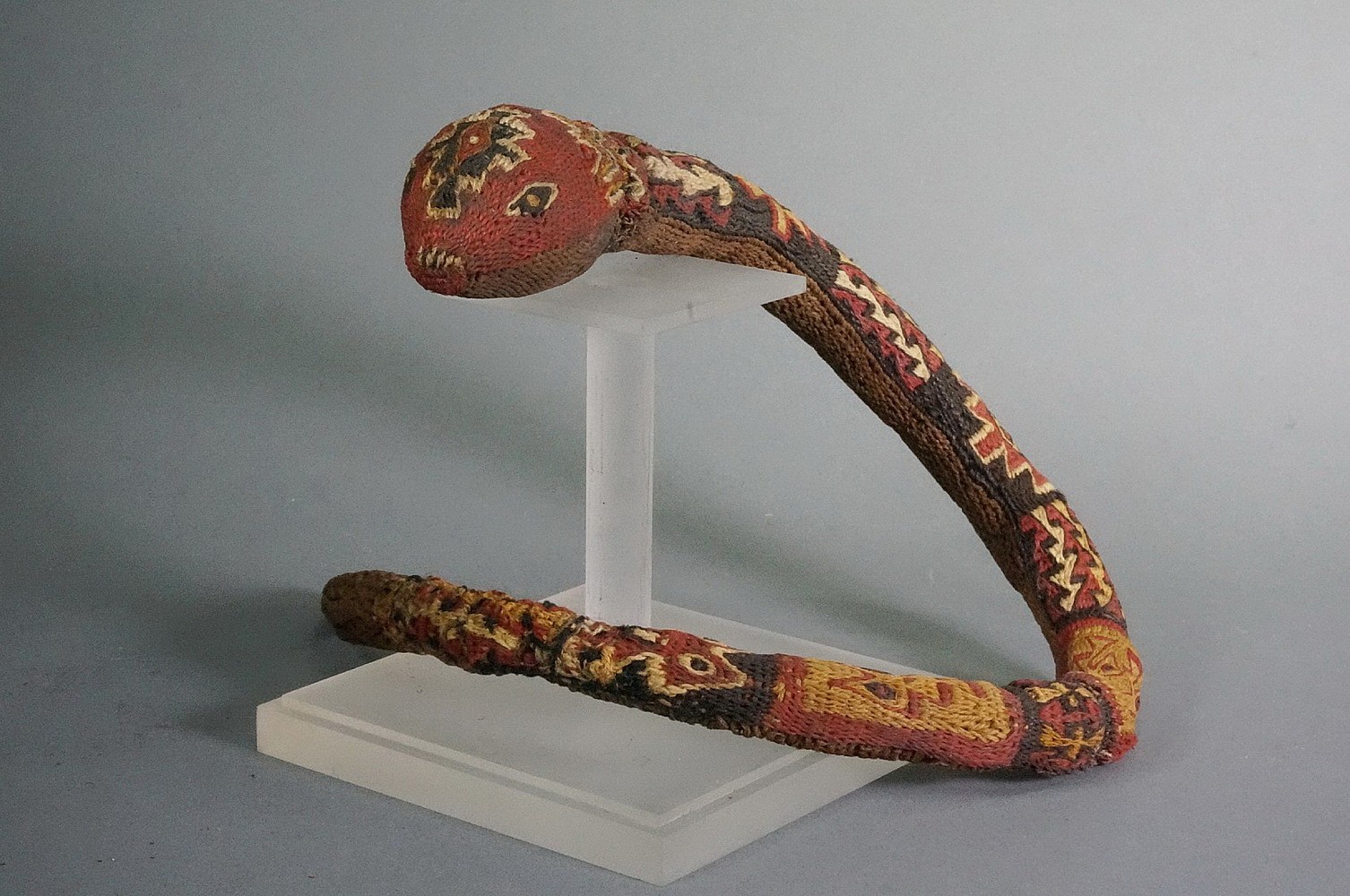




Peru, Wari three dimensional coil woven snake dance wand
Shamans use dance wands hypnotize their attendants. This wand has 6 different patterns on its back and a solid brown underside. The tip has a 3" section of woven hemp which appears to be poisonous. There are many poisonous snakes in Peru including the dangerous Bushmaster. Formerly in the collection of Justin and Barbara Kerr, acquired from Alan Lapiner in 1967.
Period: Peru, Wari, Late Phase, Central Coast, c. AD 900 - 1100
Media: Textile
Dimensions: Length: 19 1/2" x Diameter: 1 1/2" tapering to 3/8"
Price Upon Request
n7016








Peru, Wari Tie-Dye Panel in Longstrip with Diamond Resist Motif
This panel highlights the complex dye techniques which used in ancient Peru. There are two shades of red, the darker shade has been overdyed. The first time the panel was dipped into the dye bath, several circles were tied off and the entire panel was dyed red. The tied circles remained white and more circles were tied into the fabric. The panel was then dipped into a second bath of a darker red dye. This created the light red circles and the white circles on a dark red background. The ends are finished with a knit trim, dyed green, yellow, and red.
Period: Peru, Wari, South Coast, c. AD 600 - 900
Media: Textile
Dimensions: Length: 83" X Width: 4 3/4"-5"
Price Upon Request
96121
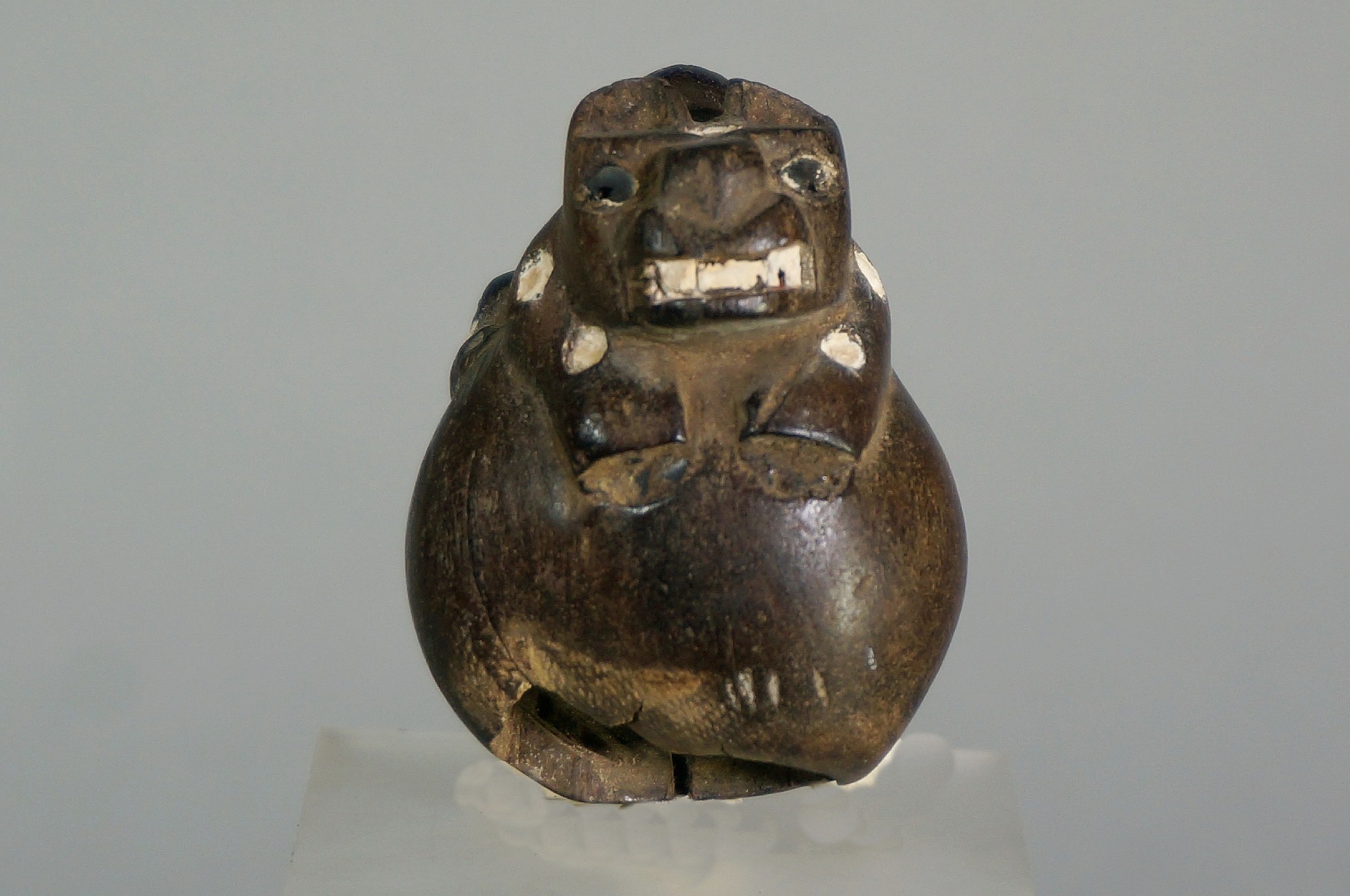





Peru, Wari Wood Lime Container with a Feline on Top with Original Shell Inlays
A small wood lime container with its original top. A recumbent feline is carved on top in high relief,
with traces of its shell teeth and spots. The bottom has been disfigured.
Period: Peru, Wari, South Coast, c. AD 600 - 900
Media: Wood
Dimensions: Height: 2"
$1,250
94265a


